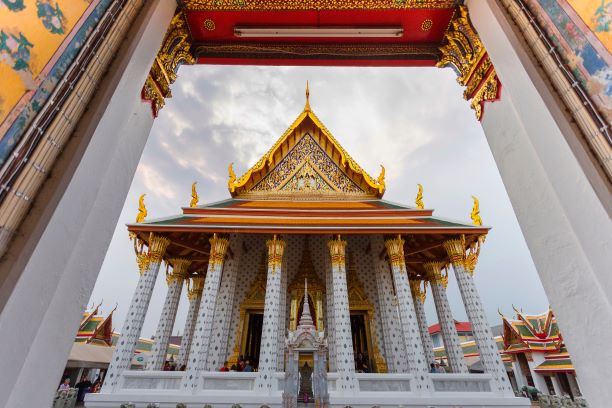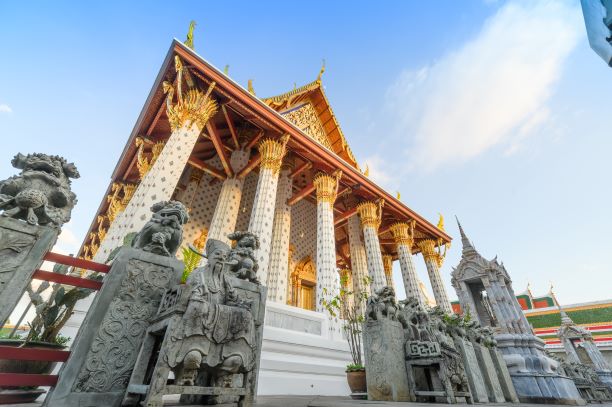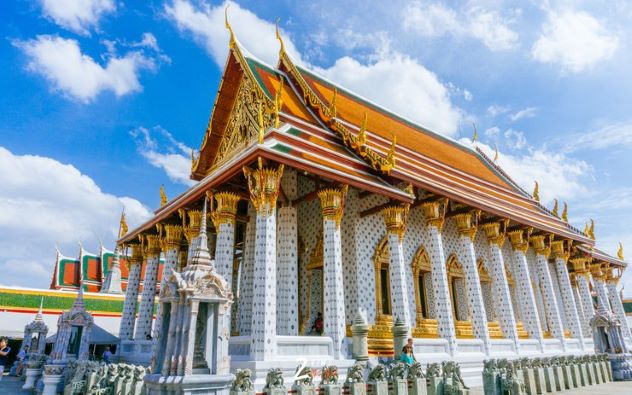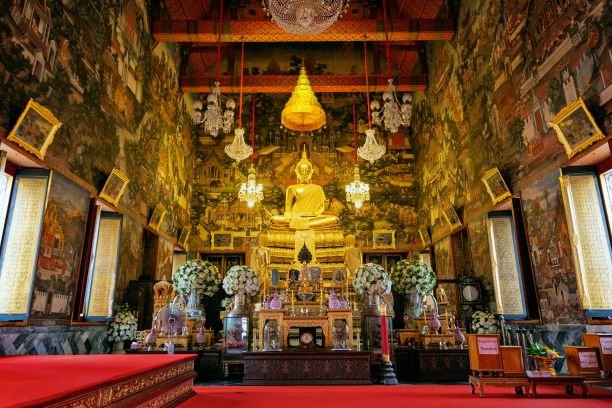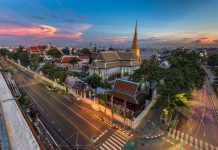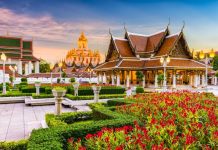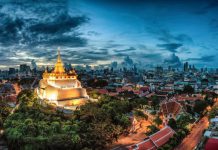
One of Bangkok’s most recognizable landmarks is Wat Arun also known as the Temple of the Dawn.
When we mentioned to “Wat Arun” or “Wat Arun Ratchawararam Ratchawaramahawihan“, it is familiar to many people in particular tourists. The beauty of the exotic and inestimable traditional architecture of the temple that stands elegantly nearby the river Chao Phraya being the iconic figure of Bangkok to the eyes of the beholders worldwide. The place lures numerous of tourists all around the world to visit, especially the stunning panorama of the temple with the rising sun as a background at dawn which is one of the most beautiful photo opportunity, indeed. The place is another valuable Buddhist temple that charms with its art and architectural characters.
Wat Arun History
Wat Arun Ratchawararam Ratchawaramahawihan or Wat Arun in short or better known in general is “Wat Chaeng” which means the Temple of the Dawn is one of the most sacred temples in Bangkok and Thailand. The temple is the top grade of the first-class royal temple (means the royal temple that the king, queen, and crown prince establish or restore in personally) and has lasted since Ayutthaya era. It situates in the west of the Chao Phraya River. The temple used to be called “Wat Makok” followed to name of Bang Makok sub-district, however, renamed as “Wat Makok Nok” later since there was a new temple was built called “Wat Makok Nai”. Then, in 1767 the King Taksin the Great planned to set up Thonburi as a new capital of Siam. So, he altogether with the troop moved down by the river until arrived at Wat Makok at dawn. Then, He renamed the temple to “Wat Chaeng” to be the good memorial on the occasion that marched to the temple at sunrise.
When King Taksin the Great relocated the capital from Ayutthaya to Thonburi, he set up the new palace and expanded the area of the royal residence. As a result, Wat Chaeng was right in the middle of the site, so that he gave the command that the temple inherited from the monk.
Moreover, the temple was a religio-political temple during the Thonburi era because at that time it was the house to enshrine the Emerald Buddha and Phra Bang. Somdet Phraya Maha Gasat Seuk (King Phra Buddha Yodfa Chulok Maharaj) enshrined the statues inside the mondop with a big celebration for 7 days and 7 nights. Nonetheless, in 1784 the Emerald Buddha relocated to Wat Phra Sri Rattana Sasadaram in the Grand Palace. Whereas, Phra Bang was transferred to return to Vientiane.
When King Phra Buddha Yodfa Chulalok Maharaj (Rama 1) accessed to the throne and found Rattanakosin dynasty, he gave the command to construct a new capital in the east of Chao Phraya River as well as removed the wall of Thonburi Palace. Therefore, Wat Chaeng was not within the area of the royal residence and permitted to allow the monks to reside in the temple. Besides, the king assigned Prince Itsarasunthon (King Rama 2) to proceed the restoration work of the temple. Unfortunately, in 1809 King Rama 1 passed away before the completion of the renovation.
Later, in the period of King Phra Phutthaloetla Naphalai (Rama 2), he continued the work until it completed. Moreover, he sculped the Buddha image by himself and ordered to cast the statue to be a leading sacred image in Ubosot of the temple. The celebration set in 1820 and the king named the temple as “Wat Arun Ratchatharam”.
And during the reign of King Mongkut (Rama 4), the temple was restored again and renamed as “Wat Arun Ratchawararam” which is the name of the temple abidingly.
The highlight of the Temple
The Central Prang
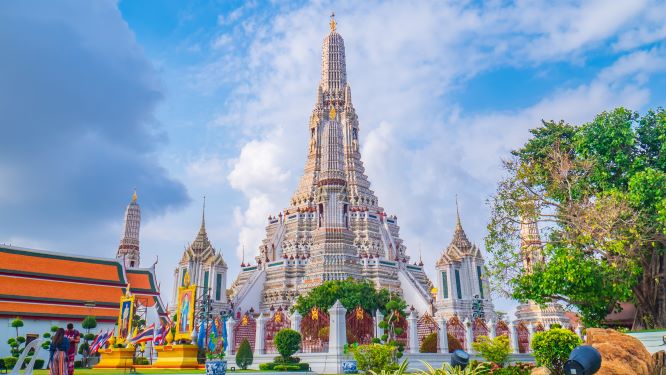
Prang (Khmer style pagoda) is the most exotic and outstanding piece of art of the temple. However, the prang exists currently is not the original one that constructed since Ayutthaya with 16 meters high only. The tower was built by the skilled artisans which enchased with colourful faience from China that is delicate ancient and rare items. The present prang is one that extended from original in the reign of King Rama 3 on the significant renovation of the temple. And the temple had been repaired continually until the period of King Rama 5.
The prang divided into 3 main parts which are Base, Ruen That, and Ruen Yod (Top). The base is the metaphor as the Mount Meru with 234 meters in its width. Over the second terrace are various figures such as the Hindu gods Vayu on the horse and Kinnorn (male) Kinnaris (female) are depicted as having the head and body of a human, and the tail and wings of a bird. And there are the figures of Garuda and Dhevaphanom above the arched space, and the top-peak of the pagoda is gilded.
The prang consists of the primary pagoda with 81.85 meters high and four satellite prangs. The 4-prangs are stucco pagoda furnished with color porcelain as same as the primary one. The satellite prangs are locating in all four directions below the central pagoda which are in the northeast, the southeast, the northwest, and the southwest. Each of them is house Hindu Indra on the Erawan with the defensive wall. The 3-layers of foundation decorated with the figure of the giants and monkeys alternately below the foundation. And there also are 4 arched space that enshrined the Vishnu Avatara and beyond is top of the pagoda with the image of Dhevaphanom Norasing (a mythical half-human, half-lion figure).

Another essential restoration of Wat Arun was started on September 24, 2013, and had processed completed. And the celebration for this occasion took place during December 27, 2017 – January 5, 2018.
The Giant (Yak)
Besides Phra Prang which is the most significant object of the temple, another remarkable structure that attracting many tourists to visit this famous temple is the “Giant of Wat Arun” or better called in general the “Giant (Yak) Wat Chaeng”. There is a myth about the battle of the Giant of Wat Pho and Wat Chaeng that caused the collapse of building around the neighbour hence that area called “Tha Tien” which means empty land.
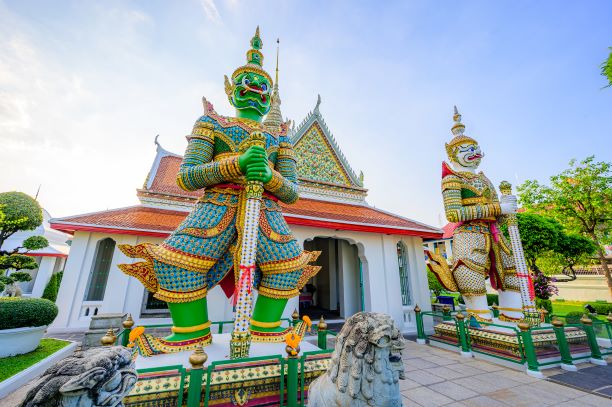
The giant of Wat Arun is standing at the archway to enter the Ubosot. The one in white called “Sahassadecha” and another in green called “Thotsakan (Ravana). The giant was created based on the Ramayana epic; nonetheless, the design is Chinese stuccowork decorated with colour porcelain and hold a big club in hand. This reflects the belief about the guardian spirit to protect the insignificant sacred monastery.
More attractive things to see in Wat Arun
1. Phra Ubosot (Ordination Hall)
The ordination hall is the place to house “Phra Buddha Thammisorarat Lokathatdilok”, the main sacred image of the building. It is a Buddha image in the attitude of Subduing Mara in Rattanakosin enshrined above the platform. The record noted that King Rama 2 sculpted the face of the statue by himself.
2. Phra Viharn Luang (the Royal Chapel)
The house of “Phra Buddha Champhunut Mahaburuslakkana Asitayanubobhit” which is the main holy image of the building. There also are Phra Arun or Phra Chaeng, a Lan Xang Buddha statue housed in the chapel.
3. The Library of Somdej Phra Buddhajarn
The library that is gathering the numbers of the collection of books – Buddhist textbook, Biography of famous Buddhist monks, History of temples, Tripitaka, Dhamma textbook, Sermon manual (Pali), and many journals. And there are the engraved sandalwood Buddha statues which are Phra Borom Sassada Sakkayamunee Buddhachao and Phra Phaisatchaya Kuru Buddhachao housed here as well.
4. Phra Ubosot Noi (the Little Chapel)
It is a former main chapel of Wat Arun, and there is the house to enshrine the statue of King Taksin for any visitors to pay respect. On the left of the image is the holy shrine of the king, and the opposite side is “Phra Taen Bunthom” (bed) that believe that King Taksin resided here during the late of his reign. And behind the statue housed “Luang Pho Rung Mongkol” the primary image of this chapel.
5. Phra Vihara Chulamanee
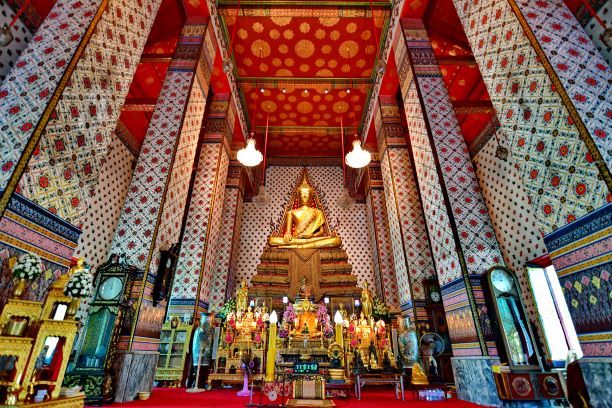
It is a large pagoda made of metal with the stucco figures of the guardian deities of four parts of earth located in all 4 corners. The little chapel, in the past, was a house to enshrine the Emerald Buddha when invited from Vientiane, Laos. Moreover, there is “Phra Taen Bunthom” or bed of King Rama 2 set inside the building as well.
Taking Tour at Wat Arun
Wat Arun sites on Arun Amarin Road nearby the Chao Phraya River on the Thonburi side, opposites from Wat Pho. To travel the temple starts from Sanam Luang and passes Na Phralan Road at the entrance of the Temple of the Emerald Buddha then turns left to Wat Pho. And before arriving at Wat Pho, there are an alley acrosses from Wat Pho to reach Tha Tien Pier for the ferry to Wat Arun (notice a signage Exchange of Bangkok Bank in front of the alley). At the pier, takes the left row to get the furry (the right one is the express boat). The price is THB3 only for both Thai and foreigner.
Once arriving at the pier, then departs from the dock to enter to the temple. Right there we can spot the charming Prang of Wat Arun that famously published in the postcard stands in front of our eyes. The environment of the temple is shady and pleasant from the big trees, and there are lawn yard, walkway, and Chinese style waterfront pavilion. The first thing that attracts to the visitors is the couple of giants standing in front of the archway to the Ubosot. The green one is Thotsakan, and the white one is Sahassadecha from the Ramayana epic. The statues are stuccowork with beautiful and colourful China. Along the way nearby the river, the visitor can spot King Rama 2 monument set up there for the people to pay respect. And beyond is the location of the Prang.
The temple allows the visitors to sightsee the Prang closely by the stairway. However, the stairs are quite high so that they may cause any danger to the tourists especially seniority and children. On the top of the Prang is the fresh and pleasant breeze and features the lovely scene surrounding Wat Arun. Particular the marvellous view of the Chao Phraya River with the Temple of the Emerald Buddha is a background which is the great photo opportunity for many tourists both Thai and foreigners to take.
To inspect the architectural design of the Prang carefully, we can notice that the structure is decorated with various materials including beautiful colour ceramic, antique porcelain, shell in flowers, leaves, and other patterns. There are numbers of demon figure around the pagoda. It reflects the wisdom and effort of the Thai artists who created the pagoda in the past.
There is refreshment shop, souvenir shop and restrooms including Thai costumes rental for any visitor to rent for photo shooting in the area of the temple. So, the visitors can take a break around this area and watch the waterfront view at the Sala (pavilion) before leaving the temple is another good idea.
Taking a tour at Wat Arun may start from making a trip in Wat Pho, and then gets the ferry to cross to Wat Arun. The recommended time to visit the temple is in the morning before noon or around 3 – 4 PM when the sun is not too strong.
The visitors to come to Wat Arun should get dress politely. And as mentioned previously, please mind your steps since the staircase is high and narrow in some parts. Moreover, the visitors should not touch or take any actions that can cause any damages to the Prang and other structures in the temple.
Information of the Temple
Operating time: Opens daily between 8.00 – 17.30 hours
Admission Fee: Free for Thai and THB50 for Foreigner
For more information can call: +66 2891 2185, +66 2466 3167,+66 2465 7742
How to Get There
BTS:
Gets off at Taksin Station S6 (route Silom) uses the Exit 2. Then arrives the Chao Phraya Express boat at Sathon Pier (Central Pier) and gets off at Tha Tien (N.8). And gets the ferry to cross from Tha Tien to Wat Arun.

